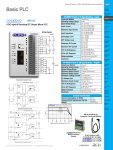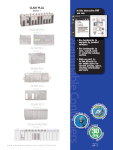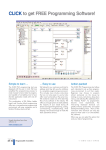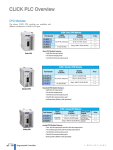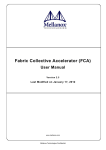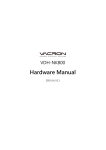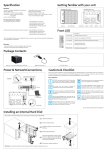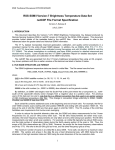Download Wiring
Transcript
Chapter 2: Specifications Standard CPU Modules 1 2 3 4 5 6 7 8 9 10 11 12 13 14 A B C D 2–4 The Standard CLICK CPU modules are available with different combinations of built-in I/O types (i.e. DC input/DC output, DC input/relay output, and AC input/relay output). With the 14 built-in I/O points (8 inputs/6 outputs), the CPU can be used as a ready-to-go PLC control system without any additional I/O modules. The CPU module just needs 24 VDC, but it can be expanded in the future if the need arises. They also have an RS-485 port for Modbus and ASCII communications, and the battery backup feature which will retain the data in SRAM for 5 years. PLC Mode Switch C0-01DD1-D 8 Discrete Input Points LED Status Indicators PWR RUN ERR PORT1 TX1 RX1 Communication Ports TX2 6 Discrete Output Points RX2 PORT2 PORT3 RS-485 TX3 RX3 Built-in I/O (Standard CPUs) There are four different configurations of I/O types available for the Standard CLICK CPU modules. The table below lists the part numbers showing the various I/O types. Standard CLICK CPUs Part Number C0-01DD1-D C0-01DD2-D C0-01DR-D C0-01AR-D Discrete Input Type Discrete Output Type External Power 8 DC (sink/source) 8 AC 6 DC (sink) 6 DC (source) 6 Relay 24 VDC (required for all CPUs) CLICK PLC Hardware User Manual, 4th Ed. – C0-USER-M Chapter 2: Specifications Memory Types The following is the list of the memory types that the CLICK PLC system supports. See the memory map later in this chapter. Symbol Data Type Input Point X Bit The Discrete Input points are represented by the "X" symbol. Output Point Y Bit The Discrete Output points are represented by the "Y" symbol. Control Relay C Bit Timer T Bit Counter CT Bit System Control Relay SC Bit Data Register DS Integer Single word integer data registers are represented by the "DS" symbol. Data Register DD Integer2 Double word integer data registers are represented by the "DD" symbol. Data Register DH HEX Single word Hex data registers are represented by the "DH" symbol. Data Register DF Floating Point Data Floating Point registers are IEEE format Real number values represented by the "DF" symbol as 32 bit words. Input Register XD HEX The Input Registers, represented by the "XD" symbol, contain groups of Discrete Input points in a 16 bit word format. Output Register YD HEX The Output Registers, represented by the "YD" symbol, contain groups of Discrete Output points in a 16 bit word format. Timer Register TD Integer The Timer Registers, represented by the "TD" symbol, contain the corresponding Timer's accumulative value in a 16 bit data register. Counter Register CTD Integer2 The Counter Registers, represented by the "CTD" symbol, contain the corresponding Counter's accumulative value in a 32 bit data register. System Data Register SD Integer The internal System Data Registers, represented by the "SD" symbol, are pre-defined words which represent the status of specific system functions. Text TXT Text The Text data registers, represented by the "TXT" symbol, are used to store and manipulate ASCII text data. Memory Type S/W Icon Definition The Control Relay bits are represented by the "C" symbol. These internal bits are typically used for ladder program control. They do not represent any real world inputs or outputs. The Timers are represented by the "T" symbol. The Timer status bit is used to indicate when the Current Value of the timer equals its Preset Value. The Counters are represented by the "CT" symbol. The Counter status bit is used to indicate when the Current Value of the counter equals its Preset Value. The internal System Control Relays, represented by the "SC" symbol, are pre-defined bits which represent the status of specific system functions. CLICK PLC Hardware User Manual, 4th Ed. – C0-USER-M 1 2 3 4 5 6 7 8 9 10 11 12 13 14 A B C D 2–13 Chapter 2: Specifications C0-01DD2-D – 8 DC Input/6 Sourcing DC Output Micro PLC Wiring Diagram C0-01DD2-D 24VDC C1 + X1 X2 + X3 X4 RUN C2 ERR X5 X6 PORT1 X7 TX1 X8 C0-01DD2-D Built-in I/O Specifications - Inputs Inputs per Module Operating Voltage Range Input Voltage Range Input Current Maximum Input Current + PWR + Input Impedance ON Voltage Level RX1 V1 Y1 L RX2 Y2 L Y3 L Y4 L PORT2 RS-485 PORT3 V2 TX3 Y5 L RX3 Y6 L OFF Voltage Level + TX2 24VDC + Minimum ON Current Maximum OFF Current OFF to ON Response CO ON to OFF Response NOTE: When using Standard CPUs, you must use CLICK programming software version V1.20 or later. Status Indicators Commons 8 (Sink/Source) 24 VDC 21.6 - 26.4 VDC X1-2: Typ 5 mA @ 24 VDC X3-8: Typ 4 mA @ 24 VDC X1-2: 6.0 mA @ 26.4 VDC X3-8: 5.0 mA @ 26.4 VDC X1-2: 4.7 k⏲ @ 24 VDC X3-8: 6.8 k⏲ @ 24 VDC X1-2: > 19 VDC X3-8: > 19 VDC X1-2: < 4 VDC X3-8: < 7 VDC X1-2: 4.5 mA X3-8: 3.5 mA X1-2: 0.1 mA X3-8: 0.5 mA X1-2: Typ 5 μs Max 20 μs X3-8: Typ 2 ms Max 10 ms X1-2: Typ 5 μs Max 20 μs X3-8: Typ 3 ms Max 10 ms Logic Side (8 points, green LED) 2 (4 points/common) Isolated General Specifications Current Consumption at 24VDC Terminal Block Replacement Part No. Weight 140 mA C0-16TB 5.0 oz (140 g) Equivalent Input Circuit C0-01DD2-D Temperature Derating Chart Internal Module Circuitry + Optical Isolator INPUT X1-X4 Typical Inputs 6 + 24 VDC 4 2 C1 COM To X2-X4 commons + 8 Points 1 2 3 4 5 6 7 8 9 10 11 12 13 14 A B C D 0 Optical Isolator INPUT X5-X8 Typical 0 32 10 50 30 85 40 104 50 55 °C 122 131 °F Surrounding Air Temperature (°C/°F) + 2–38 20 68 24 VDC C2 COM To X6-X8 commons CLICK PLC Hardware User Manual, 4th Ed. – C0-USER-M Chapter 3: Installation and Wiring Wiring Guidelines Power Input Wiring to CLICK Power Supply Connect the AC power source input wiring to the Click power supply (the Click power supply voltage and current requirements are listed in chapter 2). If you are not using a CLICK power supply, be sure to meet that supply’s requirements. Do not apply power at this time. Observe all precautions stated earlier in this manual. Warning: Once the power wiring is connected, secure the terminal block cover in the closed position. When the cover is open there is a risk of electrical shock if you accidentally touch the connection terminals or power wiring. Power Input Wiring to Click CPU Connect the 24 VDC power source input wiring to the 4-pin 24 VDC input connector located on the bottom panel of the Click PLC. Do not apply power at this time. Observe all precautions stated earlier in this manual. CLICK CPU CLICK Power Supply 24VDC 0V 24VDC 0V G G CLICK PLC Hardware User Manual, 4th Ed. – C0-USER-M 3–17 A 2 3 3 3 3 3 3 3 3 3 3 3 3 3 3 3 3 Chapter 3: Installation and Wiring Powering I/O Circuits In most applications, it will be necessary to power the input devices from one power source, and to power output loads from another source. Loads often require high-energy AC power, while input sensors use low-energy DC. If a machine operator is likely to come in close contact with input wiring, then safety reasons also require isolation from high-energy output circuits. For the DC input/output circuits, you can use the same power source as the CPU module (and I/O modules). However, you lose the isolation between the logic circuits and the input/output circuits. (For AC input/output circuits, you don’t need to worry about sharing the 24VDC.) Power Supply CPU Module Input Module Output Module Logic Circuit Logic Circuit 24VDC 0VDC Logic Circuit Lose Isolation Input Circuit Isolation Boundary Output Circuit Input Circuit Load Output Circuit Load To keep the isolation between the logic circuits and the input/output circuits, we recommend using another power supply for the DC input and output circuits. Power Supply CPU Module Input Module Output Module Logic Circuit Logic Circuit 24VDC 0VDC Logic Circuit Keep Isolation Input Circuit Output Circuit Input Circuit Output Circuit Isolation Boundary Load Power Supply Load 24VDC 0VDC CLICK PLC Hardware User Manual, 4th Ed. – C0-USER-M 3–25 A 2 3 3 3 3 3 3 3 3 3 3 3 3 3 3 3 3 Chapter 3: Installation and Wiring Sinking/Sourcing Concepts Before wiring field devices to the PLC I/O, it’s necessary to have a basic understanding of sinking and sourcing concepts. Use of these terms occurs frequently in input or output circuit discussions. The purpose of this section is to explain the terms. The short definitions are as follows: A 2 3 3 3 3 3 3 3 3 3 3 3 3 3 3 3 3 Sinking = Path to supply ground (–) or switching ground Sourcing = Path to supply source (+) or switching +V + – These terms only apply to DC circuits, not AC circuits. Input and output points that are either sinking or sourcing can conduct current in only one direction. This means it is possible to wire the external supply and field device to the I/O point with current trying to flow in the wrong direction, in which case the circuit will not operate. PLC The diagram on the left shows a sinking PLC input. To Input properly connect the external supply, connect it so the (sinking) input provides a path to ground (–). Start at the PLC input Input terminal, follow through the input sensing circuit, exit at Sensing the common terminal, and connect the supply (–) to the common terminal. Common The switch between the supply (+) and the input completes the circuit. Current flows in the direction of the arrow when the switch is closed. By applying the circuit principle above to the four possible combinations of input/output sinking/sourcing types, we have the four circuits as shown below. Sinking Input Sinking Output Input PLC PLC Output Load + – + Common Input Sensing Common + 3–26 – Common Sourcing Output Sourcing Input – Output Switch Input PLC Input Sensing PLC Common + Output Switch Output – Load CLICK PLC Hardware User Manual, 4th Ed. – C0-USER-M






